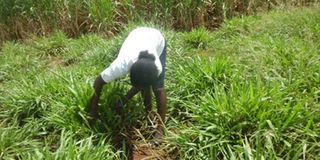Scientists roll out better, nutrient-rich animal forage

This forage species categorised as animal legume category are highly nutritious, easy to grow and by fixing atmospheric nitrogen they improve soil fertility. PHOTO BY LOMINDA AFEDRARU
What you need to know:
For many a livestock farmer, forage to feed animals is a nightmare, particularly during the dry season. Ugandan scientists at the National Livestock Resources Research Institute (NaLRRI) in Tororo have, however, come up with a number of fodders.
Small scale livestock farming in Africa can become more intensive yet sustainable if better and more nutritious forage is used to feed the animals.
This could benefit farming activities especially in rural Sub-Saharan Africa and see a shift from the increased reliance on ordinary pasture grazing.
However, apart from farmers grazing their animals on grassland owned communally, scientists are encouraging them to use hybrid fodder species in an attempt to rear animals which will be in position to produce enough milk as well as good quality beef.
One such initiative is where scientists at the National Livestock Resources Research Institute (NaLRRI) in Tororo are breeding a number of fodder species including addressing the challenge of the Napier grass being wiped out by the Napier stunt disease.
In an attempt to mitigate the devastating effects of NSD on the productivity of Napier grass, scientists have developed three varieties that are tolerant to the disease. They include Kakamega 1, accession 16702 and accession 112 that are recommended for farmer uptake especially in the Lake Victoria crescent zone where the incidence of the disease is very high.
Another initiative is where the team, in an attempt to address forage seed scarcity in the country is developing seed for various forage species including Napier grass clones tolerant to NSD, lablab, Rhodes grass, Brachiria grass, and Centro, Desmodium, and Clitoria ternatea among others.
The seed have been bulked and distributed to stakeholders in various districts in Uganda for further distribution to farmers.
This forage species categorised as animal legume category are highly nutritious, easy to grow and by fixing atmospheric nitrogen they improve soil fertility.
The acting director of the institute, Dr Halid Kirunda, explains that scientists at the institute undertook to breed the three Napier grass species mainly because the disease was wiping it out yet majority of the farmers who practice zero grazing feed their animals using this grass.
The NaLRRI team has more than 80 acres of land where different animal fodder species has been planted including on part of the land based at Nakyesasa in Namulonge.
Farmers throughout the country are expected to come to both sites to get the fodder for multiplication in their various locations free of charge but the number of farmers responding is so minimal. According to Dr Kirunda, a farmer who wants to obtain the fodder species as an individual will be required to pay a minimum fee for the labourer who is going to cut it for him but those who come as a group, the institute caters for the cost of the labour.
However, the team has so far distributed the three varieties of Napier grass to various stakeholders including interested farmers in over 50 districts in Uganda.
Another type
Another grass which is drought tolerant is the Brachaeria Molato which the scientists are encouraging farmers to grow because it has good features of regeneration and it is good for making hay which can be given to animals during the dry season.
Much as a number of farmers are used to feeding their animals using forage grass, it is advisable to give them legume forage species because it is rich in protein.
Grass forage is rich in starch, glucose and carbohydrate food nutrient and provides 70 per cent of animal feed nutrients which should be supplemented by 30 per cent provision of protein obtained from legume forage.
Farmers are advised to grow the legume forage through intercropping with plants like maize. According to Dr Kirunda, the legume forage species are not easy to multiply but farmers are encouraged to obtain the seed and plant them. It can turn out to be a good business prospect for a farmer specialising the legume forage species because such a farmer will be supplying seed to fellow farmers at Shs30, 000 per kilogramme.
A good number of farmers especially those practicing zero grazing in the districts of Masaka, Katakwi, Jinja, Kamuli, and in western Uganda are already feeding their animals on the improved fodder species.
The farm manager Mr Joseph Okring, said it is much easier to set nursery beds of some of the forage species especially tree forage species within the Institute which is later transplanted if the institute farm and some farmers come to purchase the seedlings directly.
This is mainly for the calliandra tree species and boto brass bee forage eucalyptus tree mainly used by bee keepers for setting up their bee hives. The Calliandra tree species is multipurpose because it can be used to feed all the animal species bred by Ugandan farmers such as goats, cattle and sheep.
He advises farmers to mix dry hay with molasses in order to get a good feed ingredient before it is given to the animals.
Some of the forage species planted on the institute land include, canavalia maritima, Klitoria ternateńska, centrosema virginianum, lablab, mukuna, molasses grass, bufalo grass, Sugarcane Napier and torch grass among others. The Institute sits on 770 hectares of land and about 60 hectares is used for growing different fodder species.




